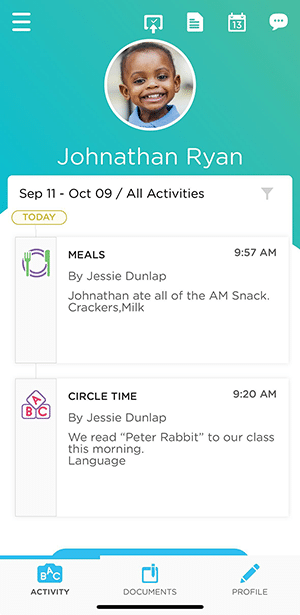Creating a daycare parent handbook, also known as a parent or family handbook, for your child care center is an important task. Let’s take a look at the benefits of having one for your daycare business and 10 items your handbook should cover!
What is a Daycare Parent Handbook?
A child care handbook, also called a parent or family handbook, is an important document that outlines the philosophies, policies and operating details of the daycare center it represents.
Think of it as the foundation of communication between you and the families you serve. As long as you keep your handbook updated, your customers will always know what to expect from you and your team.
This knowledge will breed confidence and help your child care business avoid awkward situations and/or legal issues that may arise in the future.

What Is the Purpose of a Child Care Handbook?
Let’s explore the three main benefits of having an updated child care handbook:
1. Set Expectations
Your handbook will allow you to set expectations — for both families and their children — from the onset. Clear expectations regarding child pick-up, tuition payments and communication will help you avoid problems down the road.
2. Boost Productivity
Once you’ve written your handbook, you won’t have to waste time explaining to parents your center’s operating hours, curriculum details or philosophies on discipline. You’ll simply send them a link to your document, which they can peruse on their own time.
3. Increase Revenue
A well-thought-out child care handbook will give your center a sense of professionalism. This will, in turn, boost customer confidence that you can provide quality care to their children, which will keep them paying your monthly tuition.
What Should be in My Child Care Handbook?

Here are 10 items to include in your child care handbook:
1. A Welcome Message
Start your handbook with a friendly welcome message. Doing so will give you the chance to explain why you do what you do and connect with parents on a deeper level. It will also help set the tone for the rest of the document.
Just remember to keep your welcome message short and sweet.
Pro Tip: A picture of you and your staff can make your handbook feel more personable.
2. Operating Information
Your child care handbook should also include basic information like your center’s full name and address, contact details, facility hours and a calendar with planned “off” days. That way parents have an easy way to reference these things when they need them.
3. Your Child Care Philosophy
Next up, your child care philosophy. This section is very important and one of the main things potential customers will look at when assessing your daycare center.
This section is your opportunity to explain your child care business’s approach to early childhood education, discipline and family engagement. For example, does your center teach academic skills or does it focus on play-based learning (or both)?
By outlining these crucial details, you’ll make it easy for families to determine if your center is right for their child. You’ll also set expectations and help guard against complications.
4. Enrollment and Tuition Details
How should parents enroll their children in your daycare? Do you have a waitlist? If so, do returning parents get preference or access to early enrollment periods? Also, what do you charge to care for children in each age bracket and when is payment due?
Your handbook needs to include these details.
Don’t forget to share withdrawal information, too. State your notification procedures, advanced notice guidelines and potential penalties in your child care handbook.
5. Sign-In and Pick-Up Process

Families will want to know about your center’s sign-in and pick-up processes.
Do you offer contactless sign in? Are there additional fees for early arrivals? How do you handle non-parent pick-ups? Describe each of these processes in your handbook so that parents know exactly what to expect and how to prepare.
Pro Tip: If you run your child care business out of your home, you may need to specify where parents should park, if they’re allowed to pull into your driveway and other similar details.
6. Daily Schedule Examples
The more detail you give parents about your center’s day-to-day operations, the better. You’re going to be caring for the people they care about most. That’s why we suggest including a daily schedule example in your child care handbook.
Specify when meals are served, when naptime happens, various programs and activities available to children and anything else that you think is relevant.
This section of your handbook is a great place to explain your center’s curriculum as well. Do you have standard lessons you teach to kids? Are you committed to helping them reach specific developmental milestones? Put these details in the document.
7. Discipline Philosophy and Process
Different families have different approaches to discipline. Because of this, you need to clarify how your center handles misbehavior. That way parents know from the beginning if your philosophies match their own and can make an accurate assessment of your business.
Use this section of your child care handbook to define what’s acceptable and what’s not, how misbehavior is dealt with and how parents will be notified when discipline occurs.
Pro Tip: Explain how your staff is expected to behave toward students too, and how they’ll be disciplined if they break the rules.
Pro Pro Tip: Discipline can be an uncomfortable topic for child care business owners. To reduce awkwardness, view licensing codes in your area to learn how your local government mandates daycare center discipline. Then base your policies on these regulations.
8. Parent Communication Channels

Your handbook already includes basic contact details such as your center’s phone number and email address. But family communication should extend far beyond these channels.
Do you use a solution like the Procare child care mobile app to communicate with parents? Check out the screenshot above and take note of the Documents icon at the bottom.
Are you planning to host parent-teacher conferences on a frequent basis? Let families know how you expect to meet and what they need to bring. What’s the best way for parents to contact you regarding non-emergency concerns? Give them the details.
Communication between your center and your customers is essential. Make sure this section in your handbook addresses your approach to communication.
9. Health and Safety Procedures
This is another important part of your child care handbook. Families will want to know how your center handles things like child-to-staff ratios, outdoor playtime safety, medication management, child allergies and medical emergencies.
Your handbook should also speak to your policies on child illness. What happens if a child gets sick at your daycare? How long do parents have to pick them up? When can they return? These details should be made crystal clear in your parent document.
In all areas of child health and safety, follow state regulations. And let parents know where they can check your center’s certifications and accreditations if they so desire.
10. Forms to Complete
Finally, include a checklist of forms for parents to fill out and turn in before their child’s first day at your child care center. This will make it easy for families to keep track of their paperwork and ensure everything is on the up and up from the very start.
Make Sure Families Read Your Handbook

It doesn’t matter how useful your child care handbook is if families don’t read it. And remember to require a signed acknowledgement they did indeed read it.
And today’s families expect a digital version that you should provide them by email and through an app.
The eDocuments feature in Procare lets you create, format, digitally sign and store important documents all in one place. Having your documents online ensures that family and staff data are in sync and quickly available.
Use eDocuments to send and manage all sorts of documents, including handbooks, enrollment contracts, incident reports, permission slips and more! And families can electronically sign and return documents to you.
It’s one way to stay connected with families with the Procare child care mobile app, which gives you the ability to:
- Share information quickly
- Take the hassle out of check-in/out
- Have a direct mass communication channel
- Keep parents engaged
- Go digital with documents and more
- Empower your staff
- Collect tuition and payments effortlessly
It saves child care programs time and money by streamlining core administrative functions while raising the bar for the parent experience with professional communications, easy-to-access portals and the ability for real-time updates from the classroom.
Check out this on-demand webinar to learn more about the app and see for yourself what it can do, for sharing daycare handbooks and beyond!


